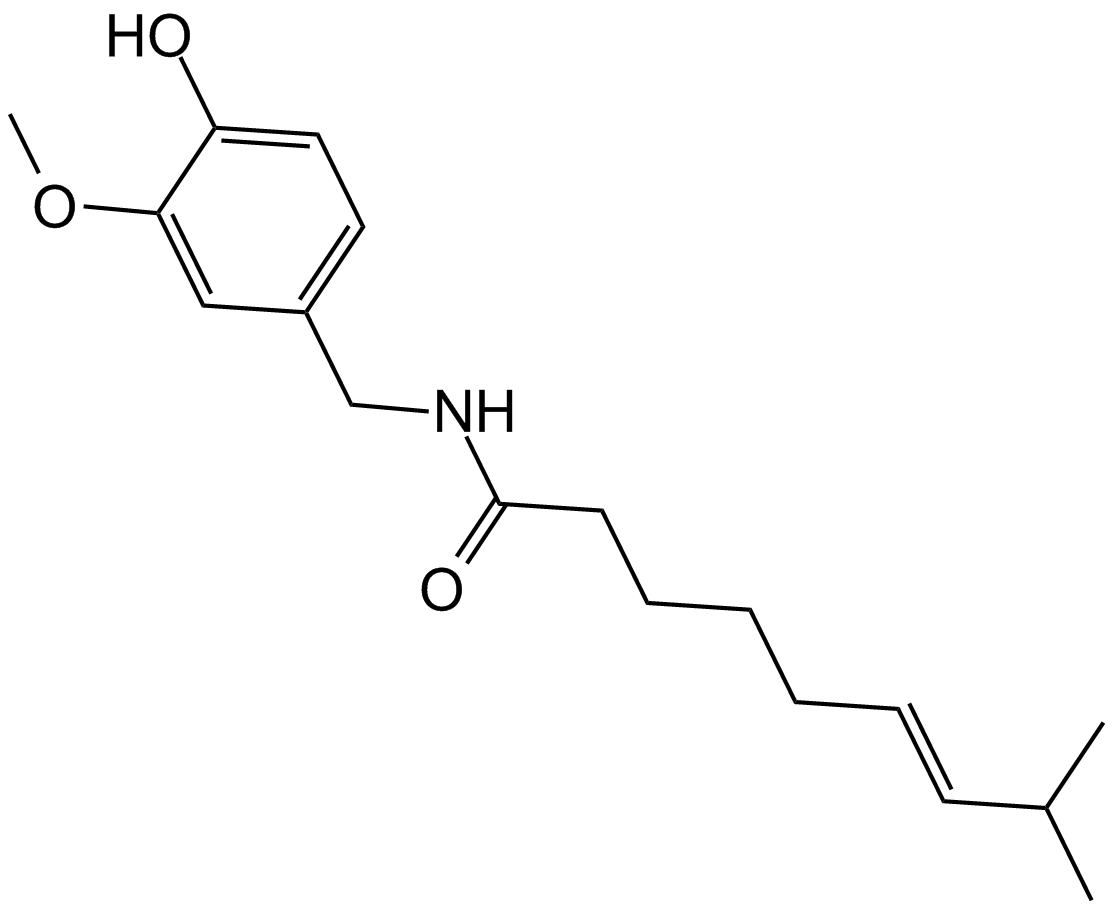Capsaicin |
| Catalog No.GC14065 |
A terpene alkaloid with diverse biological activities
Products are for research use only. Not for human use. We do not sell to patients.

Cas No.: 404-86-4
Sample solution is provided at 25 µL, 10mM.
Capsaicin is a highly selective agonist for the transient receptor potential cation channel, subfamily V, member 1 (TRPV1), a ligand-gated, nonselective cation channel, preferentially expressed on small-diameter sensory neurons [1]. capsaicin inhibits CYP1A2, CYP2C9, and CYP2C19, with IC50 values of 2.1, 2.0, and 3.2 μM, respectively, and inhibits CYP2B6, CYP2D6, CYP3A4, and CYP3A5 with extrapolated IC50 values of 24, 18, 38, and 12 μM, respectively [2].
Capsaicin inhibited Human cervical carcinoma HeLa growth (IC50 ~30 μM) and increased intracellular calcium, with effect blocked by capsazepine [3]. Capsaicin induced Human glioblastoma A172 apoptosis at ≥200 μM, not inhibited by capsazepine or BAPTA/AM 250 μM reduced basal generation of ROS and lipid peroxidation H2O2 reduced apoptosis, while NAC enhanced [4]. Capsaicin reduced Human urothelial cancer RT4 growth (IC50=80 μM) via a TRPV1-dependent process, induced cell cycle arrest in G0/G1 phase Apoptosis occurred [5].
Capsaicin pretreated ICR mice CD-1 mice with 2.5 μmol reduced VC-induced (5.8 mol) and TPA-promoted tumor incidence (by 62%) at 22 weeks (ICR) 1 μmol topical capsaicin 24 and 1 hr before, also significantly inhibited tumors induced by topical BP (0.3 μmol) then promoted with TPA (CD-1) [6]. Gavage with capsaicin significantly elevated phase II enzymes in liver and colon Oral capsaicin at 500 ppm for 4 weeks significantly inhibited ACF formation induced by AOM (20 mg/kg body weight, once a week for 2 weeks) In a 38-week study, 500 ppm capsaicin during the 4-week initiation phase significantly reduced (60%) incidence of colonic adenocarcinoma [7].
References:
[1]. Bley, K.; Boorman, G.; Mohammad, B.; McKenzie, D.; Babbar, S. A comprehensive review of the carcinogenic and anticarcinogenic potential of capsaicin. Toxicol. Pathol. 2012, 40, 847-873.
[2]. Babbar S., Chanda S., Bley K. (2010). Inhibition and induction of human cytochrome P450 enzymes in vitro by capsaicin. Xenobiotica 40, 807-16.
[3]. Takahata K., Chen X., Monobe K., Tada M. (1999). Growth inhibition of capsaicin on HeLa cells is not mediated by intracellular calcium mobilization. Life Sci 64, PL165-71.
[4]. Lee Y. S., Nam D. H., Kim J. A. (2000). Induction of apoptosis by capsaicin in A172 human glioblastoma cells. Cancer Lett 161, 121-30.
[5]. Amantini C., Ballarini P., Caprodossi S., Nabissi M., Morelli M. B., Lucciarini R., Cardarelli M. A., Mammana G., Santoni G. (2009). Triggering of transient receptor potential vanilloid type 1 (TRPV1) by capsaicin induces Fas/CD95-mediated apoptosis of urothelial cancer cells in an ATM-dependent manner. Carcinogenesis 30, 1320-29.
[6]. Surh Y. J., Lee R. C., Park K. K., Mayne S. T., Liem A., Miller J. A. (1995). Chemoprotective effects of capsaicin and diallyl sulfide against mutagenesis or tumorigenesis by vinyl carbamate and N-nitrosodimethylamine. Carcinogenesis 16, 2467-71.
[7]. Yoshitani S. I., Tanaka T., Kohno H., Takashima S. (2001). Chemoprevention of azoxymethane-induced rat colon carcinogenesis by dietary capsaicin and rotenone. Int J Oncol 19, 929-39.
Average Rating: 5 (Based on Reviews and 30 reference(s) in Google Scholar.)
GLPBIO products are for RESEARCH USE ONLY. Please make sure your review or question is research based.
Required fields are marked with *




















